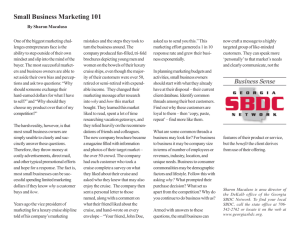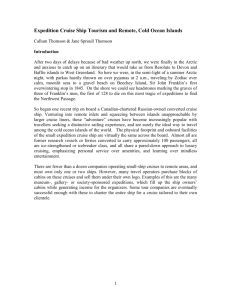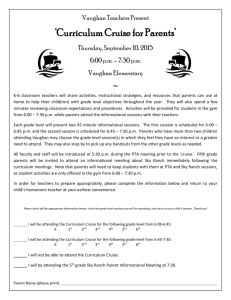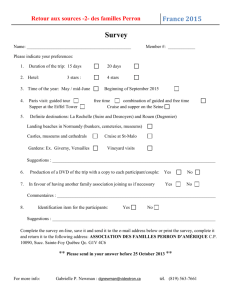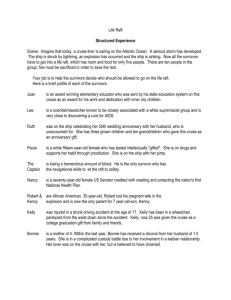IPC Syllabus
advertisement
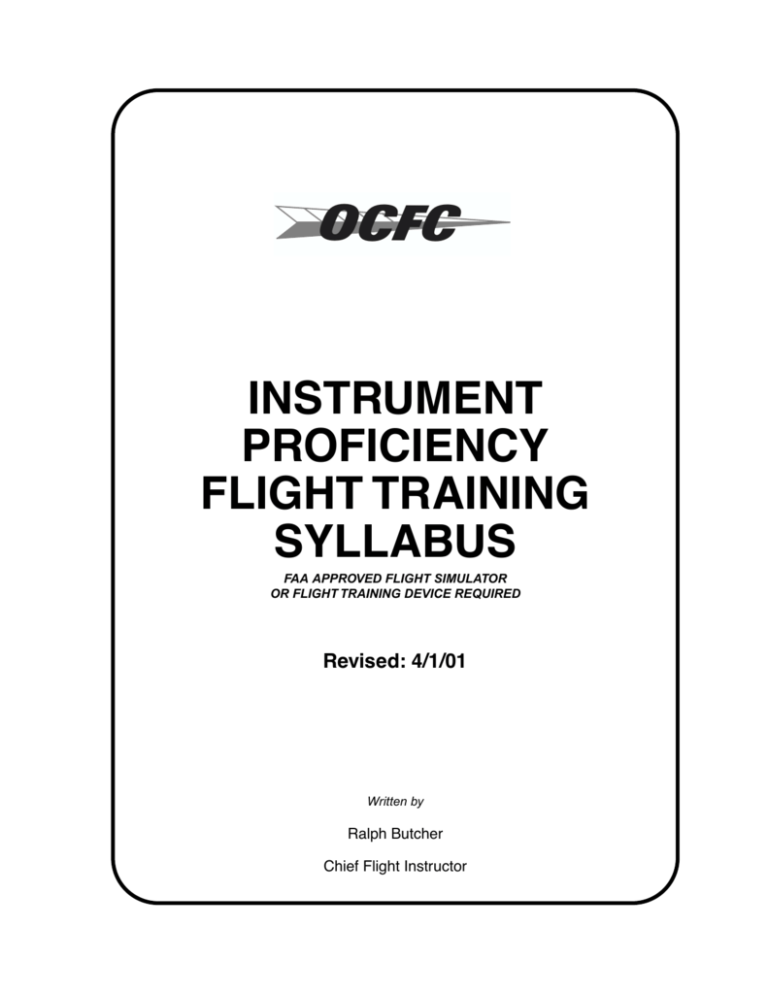
OCFC INSTRUMENT PROFICIENCY FLIGHT TRAINING SYLLABUS FAA APPROVED FLIGHT SIMULATOR OR FLIGHT TRAINING DEVICE REQUIRED Revised: 4/1/01 Written by Ralph Butcher Chief Flight Instructor General Determining the pilot’s current proÞciency level is the Þrst step of recurrent training. When accomplished, the instructor will work on raising the proÞciency level to the desired standard. One out of ten instrument-rated pilots that ßy the AST 300 simulator for the Þrst time do an excellent job. This indicates that they have received proper basic training in instrument ßying skills, an endeavor that requires 10 to 15 hours of basic instrument ßight instruction. Unfortunately, most general aviation pilots receive poor instrument training. When a pilot has problems ßying the AST 300 simulator, it can always be attributed to this fact. Recurrent instrument training begins with scan training and the complete mastery of Skyroamers® four step scan procedure, instrument interpretation, and aircraft control. This is followed by ßight control coordination exercises and radio navigation procedures: orientation, intercepts, tracking, holding, and approaches. Singlepilot en route ßying is the last step, and emphasis is placed on proper cockpit management and operating with partial panel references and only one navigation receiver — VOR and ADF. Instructor's note: Always complete the training log on the last page, and briefly state what you did on the pilot's last lesson. Remember, you may or may not be the instructor giving the next lesson.. Basic Training Elements (Simulator) A. B. C. D. E. F. G. H. I. J. K. L. M. Trimming an airplane that has three-axis trim (elevator, rudder, aileron). Introduction to the four step scan. Demonstrating the graveyard spiral and the importance of using the triangles of knowledge Flying with hands-off the yoke. 1. Controlling the airplane with rudder. 2. Pitch trimming with power. Straight and level ßight. 1. Slow cruise 2. Normal cruise. Elevator/throttle coordination. 1. When maintaining a constant airspeed. 2. When maintaining constant altitude or vertical speed. Climbs and level-offs. 1. Normal cruise – best rate climb – normal cruise. 2. Normal cruise – cruise climb – normal cruise. 3. Slow cruise – best rate climb – slow cruise. Descents and level-offs 1. Normal cruise – cruise descent – slow cruise 2. Normal cruise – slow cruise descent – slow cruise. Descending and climbing turns with intermediate level-offs and roll-outs to speciÞc headings. Vertical S with and without the attitude indicator. Vertical S-1 with and without the attitude indicator. Oscar pattern with and without the attitude indicator. Multiengine (if applicable)—using the rudder to initiate engine failure procedures. Intermediate Training Elements (Simulator) A. Ground training: 1. Aeronautical Information Manual—IFR procedures 2. Jeppesen Airway Manual Introduction and Glossary sections B. VOR and NDB orientation C. VOR and NDB course intercepts OCFC INSTRUMENT PROFICIENCY SYLLABUS page 2 D. VOR and NDB course tracking to include the bracketing procedure for crosswind and the VOR funnel E. Holding patterns: 1. VOR 2. ADF 3. Intersection F. Instrument approaches: 1. VOR 2. ADF 3. LOC 4. LOC back course 5. ILS G. Missed approaches H. Transitioning from slow cruise approach speed at 200 feet AGL with ßaps up to a full-ßap landing. I. The departure proÞle J. DME arcs (if applicable) K. Multiengine (if applicable)—engine failures. 1. Engine failures during takeoff, initial climb, and cruise. 2. Single-engine precision and non precision approaches. Advanced Training Elements (Simulator) A. Ground training: 1. FAR Part 1, 61, and 91 2. ATC communications summary (refer to the OCFC CFI Reference Manual) (INSTRUCTOR’S NOTE: Use OCFC’s “Detailed IFR Syllabus Simulator Lessons” handout for the following lessons.) B. C. D. E. Single VOR, non radar instrument ßight from TOA to Corona (AJO) and RIV. (Stage 2, Lesson 2) Dual VOR, radar controlled instrument ßight from LGB to BUR. (Stage 2, Lesson 3) En route instrument ßight from SNA to BFL, SBA, and return. (Stage 3, Lesson 4) En route instrument ßight from San Jose to Stockton. (Stage 3, Lesson 5) Advanced Training Elements (Airplane) A. B. C. D. E. F. F. G. 360-degree, 45-degree bank steep turns Recovery from unusual attitudes using partial panel VOR orientation and course intercepts (Hook, line, and sinker) VOR and intersection holding Selected precision and non precision approaches Circling approaches to include the circle-to-land maneuver Selected en route ßights to obtain Þnal proÞciency Multiengine (if applicable) 1. Engine failures during takeoff, initial climb, and cruise. 2. Single-engine precision and non precision approaches. 3. Single-engine circling approaches to include the circle-to-land maneuver. CFI NOTES: OCFC INSTRUMENT PROFICIENCY SYLLABUS page 3 DATE CFI INIT. GND TIME SIM TIME OCFC INSTRUMENT PROFICIENCY SYLLABUS LESSON CONTENT page 4
